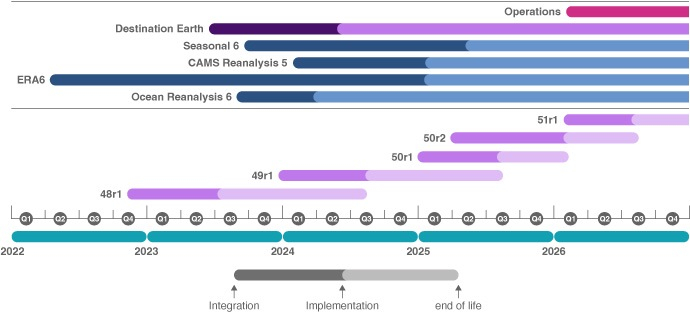

Since 2010 we have started to move from GRIB1 to GRIB2 as our standard data output format. There are several advantages to this migration, such as richer meta-data leading to enhanced data discovery, more efficient compression of data which helps reduce the size of archived data, and support for complex parameters, as well as GRIB1 being deprecated by the World Meteorological Organization. There are, however, some changes in parameter definitions and encoding methods which require careful adaptation of workflows to minimise disruption to users.
Sebastien Villaume, Senior Analyst working on the migration, said: “We know that GRIB2 brings undeniable benefits but naturally it requires adaptation, so we recognise that the migration will impact our users. We are following a phased approach taking into account users’ requirements. We will provide support and address specific challenges faced during this transition.”
What will happen
Our roadmap for moving to GRIB2 is phased under the following guiding principles:
- Any new dataset with a new type of data not existing in GRIB1 will be produced entirely in GRIB2.
- Any new dataset replacing an existing dataset that is produced in GRIB1 will also be produced entirely in GRIB2.
- Any new parameter will be defined only in GRIB2.
The amount of work and the scale of the changes does not allow everything to be migrated at once. While both data formats will continue to co-exist for several more years, users are advised to start planning for the migration by identifying areas where a change will be needed in their workflows, for example with modifications of scripts, adjustments in access methods (including the retrieval of MARS data), and even the deprecation of certain features and parameters.
Next steps and timeline
Our teams are already working closely with users to ensure the disruption is kept to a minimum, and that possible impact is mitigated as much as possible.
The next products that will be delivered in GRIB2 format only include: EAC5, ERA6, ORAS6, and SEAS6.

This migration roadmap indicates when GRIB2 is to be introduced in all of ECMWF’s weather forecasting operations (from IFS Cycle 50r2) and when various other services that will use GRIB2 will become operational. IFS Cycle 50r2 will be a purely technical cycle, with output produced in GRIB2 only but otherwise scientifically identical to IFS Cycle 50r1, which will be the final operational cycle to still produce output in a mix of GRIB1 and GRIB2.
Reassuringly, this transition doesn’t require complete rewriting of applications and tools, and user interaction with GRIB2 messages via ecCodes will be the same as in GRIB1, for example.
Sebastien added: “The migration to GRIB2 is an essential step to support the future resolution upgrades and data requirements planned in ECMWF’s 10-year strategy, and it will bring numerous advantages. Users are invited to stay informed on the migration to GRIB2 via the emailing list and web page.”
This web page will be updated regularly so you can follow the latest developments as they happen.
Stay informed with technical information and support
We have a dedicated user space for the latest information, release notes, and bug fixes. You can also ‘watch’ the page for updates.
You can also join our mailing list and we will send relevant updates. Send an email to sympa@lists.ecmwf.int with the subject 'SUBSCRIBE mtg2 at lists.ecmwf.int'.
